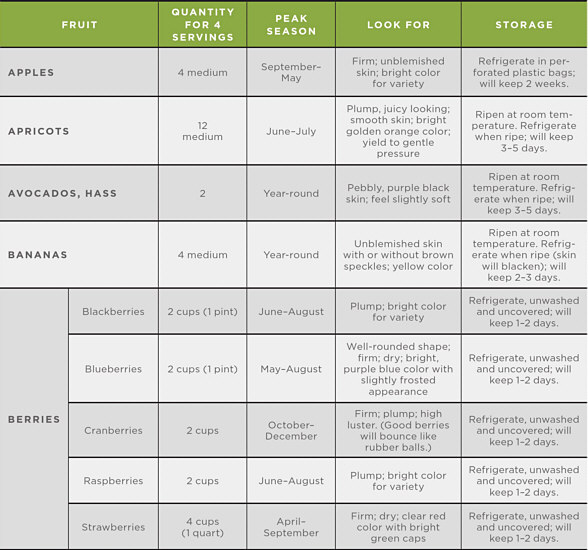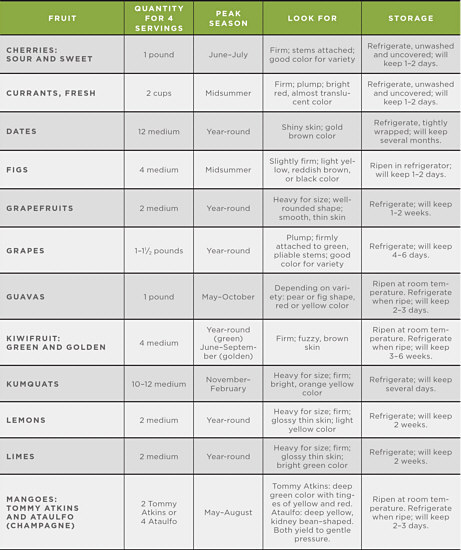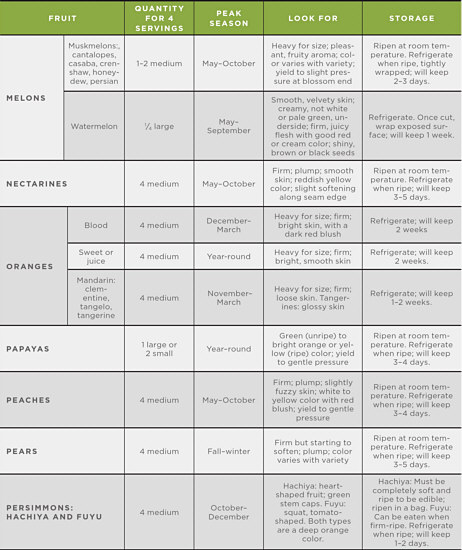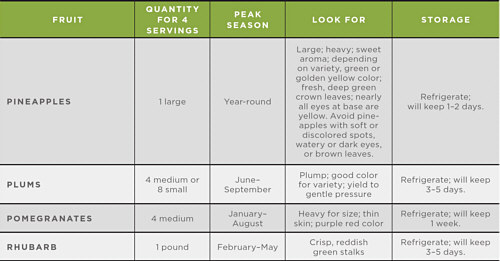Fruit is nature’s fast food: Grab a piece of fresh fruit and eat it while you’re on your way somewhere; keep a stash of dried fruit at your desk for snacks; slice fresh fruit to have on top of cereal or stirred into yogurt; or put it into a blender or a juicer to make a naturally sweet drink.
And that’s just the beginning: Fruit pairs beautifully with savory dishes, from chicken to shrimp, grains to vegetables, ham to lamb. And if you dress fruit up just a little more, you have a vast array of breads, pastries, cakes, cookies, pies, and dozens of other desserts … not to mention preserves, jams, and jellies (see “Jams & Jellies,” page 649). It’s hard to imagine a well-stocked kitchen without fruit in some form.
The bonus with fruits—and it’s no small bonus—is that many of them contain substantial amounts of heart-healthy fiber as well as some of the most powerful antioxidants found in any food (see “Antioxidants in Food,” page 7). So, here you have a food that tastes delicious and is good for you? Not bad.
Buying Fruit
Fresh: Fruit that is at the peak of its local growing season (see “Choosing & Storing Fresh Fruit,” page 89) boasts the highest quality and often the most reasonable price. Look for firm, plump fruit with bright, full colors and no dark, soft, bruised areas or other signs of aging or decay. A fruit that feels heavy for its size is often the juiciest. But be wary of oversize specimens; they can be fibrous and pithy. Look for fruit that is just ripe. Refrigerated, ripe fruit will keep for several days, whereas unripe fruit may never ripen and, of course, overripe fruit spoils rapidly. Since ripe fruit does deteriorate quickly, buy only the quantity you can use within a few days.
Purchase fresh fruit directly from the grower whenever you can. A pick-your-own operation is the best buy, where you can select the choicest fruit and pick it yourself. What could be fresher? Otherwise, shop in a market that has a fast turnover of fresh produce that is displayed in chilled cases, or at least not in direct sunlight.
Frozen: Frozen fruit has most of the flavor and all of the nutrients of fresh fruit but usually lacks optimum texture. However, it is a great option for making baked fruit desserts or sauces off-season. Be sure to buy unsweetened fruit. Choose packages whose pieces of fruit rattle around inside. If the pieces are not loose, they have probably thawed and refrozen into a solid block. Each time thawing and refreezing take place, ice crystals form, breaking down some of the fruit’s cell walls. Eventually, the fruits take on the texture of a watery puree.
Canned: Always read the label of canned fruit, which will tell you whether the fruit is packed in natural juice or in a sugar syrup; whether the fruit is whole or has been cut into halves, slices, or odd-shaped pieces; and whether the fruit is Grade A (U.S. Fancy), Grade B (U.S. Choice), or Grade C (U.S. Standard).
Grades are based on color, texture, flavor, shape, and freedom from defects. Since the nutritional values of all grades are the same, you may want to use Grades B or C, which are lower in price than Grade A, for making cobblers and other dishes in which flavor is more important than appearance.
Dried: There are several advantages to using dried fruit. You can store it in any cool, dry place, taking up little space, and it travels well to picnics and lunches. Pick up a package of fruit and squeeze it gently; quality dried fruit is pliable. Dried fruit available in natural foods stores is usually slightly darker in color since it contains none of the preservatives used to keep the fruit’s color bright.
Storing Fruit
Fresh: Unripe fruit ripens nicely at room temperature and out of direct sunlight. If you are in a hurry, put it in a paper bag to ripen. Twist the top of the bag to lock in the air. If you have a banana or an apple handy, put that in the bag too. The ethylene gases naturally given off by the ripe fruit will help the unripe fruit ripen. Check the progress every 24 hours.
Once ripe, fruit should be stored in the refrigerator. You can wash and dry them either before or after chilling. (Berries, strawberries, and cherries are the exception; they should always be stored unwashed.) Avoid crowding the pieces, and put them in the crisper section or in plastic bags. There, most fruit will remain plump and firm for 2 to 5 days. For longer storage, fruit should be frozen, canned, or dried (see “Preserving,” page 621).
Frozen: Store frozen fruit at 0°F or lower, a temperature at which it will retain high quality for 8 to 12 months. Never refreeze a fruit once it has thawed; the fruit’s firm texture will surely deteriorate.
Canned: Stored in a cool, dry place, homemade or store-bought canned fruit will maintain its quality for as long as a year. If you keep them longer than that (or keep them in a warm place), quality will suffer even though the contents will still be safe to eat.
After opening a can of fruit, you can leave the remaining portion in the open can if you cover and refrigerate it. Stored that way, however, some fruits acquire an unpleasant, if harmless, metallic taste. Instead, remove from the can and store in a jar or dish. Use within 3 days.
Dried: In hot, humid weather, refrigerate dried fruits. The rest of the year, they keep well at room temperature in a tightly covered container.
CHOOSING & STORING FRESH FRUIT
Fruit bought in season will be cheaper and better tasting, however it’s a little difficult these days to pinpoint exactly when a fruit’s peak season is. Some fruits—such as strawberries—grow in all parts of the country and can truly be said to have a local growing season. But for most parts of the country, a vast majority of fruit in the market is imported from somewhere else (there are no locally grown bananas in Michigan, for example). In addition, much of the fruit grown in tropical and subtropical regions is available in our markets year-round. Therefore, the “peak seasons” listed below merely represent times of the year when certain fruits are more abundant, and therefore less expensive. There are a few exceptions though: Cranberries, apricots, cherries, and pomegranates still have a relatively small, seasonal window of availability.



